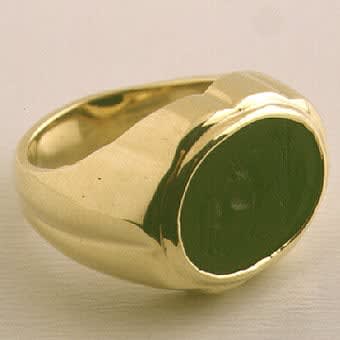Classical Revival Intaglio of a Horse and Shield, 1700 CE - 1800 CE
Onyx-Gold
FJ.6380
This Intaglio is Set in an 18 Karat Gold Ring The art of glyptics, or carving on colored precious stones, is probably one of the oldest known to humanity. Intaglios,...
This Intaglio is Set in an 18 Karat Gold Ring
The art of glyptics, or carving on colored precious stones, is probably one of the oldest known to humanity. Intaglios, gems with an incised design, were made as early as the fourth and third millennia BC in Mesopotamia and the Aegean Islands. They display a virtuosity of execution that suggests an old and stable tradition rooted in the earliest centuries. The tools required for carving gems were simple: a wheel with a belt-drive and a set of drills. Abrasives were necessary since the minerals used were too hard for a "metal edge. A special difficulty of engraving intaglios, aside from their miniature size, was that the master had to work with a mirror-image in mind.
In ancient times the horse was regarded as an elite possession used in warfare, racing and hunting. The wonderful prancing horse on this intaglio has one leg lifted as he turns his lovely head to look behind. His body is very finely engraved with considerable realism. His two ears may be interpreted as horns, which gives the animal a mythical appearance. At Rome, a horse race preceded the sacrifice to Mars, god of war. Perhaps the engraver had this connection in mind when adding the shield in the foreground in front of the two trees. One of the most beloved of all animals is here given full expression in an elegant setting that reminds us of ancient Greece and Rome.
The art of glyptics, or carving on colored precious stones, is probably one of the oldest known to humanity. Intaglios, gems with an incised design, were made as early as the fourth and third millennia BC in Mesopotamia and the Aegean Islands. They display a virtuosity of execution that suggests an old and stable tradition rooted in the earliest centuries. The tools required for carving gems were simple: a wheel with a belt-drive and a set of drills. Abrasives were necessary since the minerals used were too hard for a "metal edge. A special difficulty of engraving intaglios, aside from their miniature size, was that the master had to work with a mirror-image in mind.
In ancient times the horse was regarded as an elite possession used in warfare, racing and hunting. The wonderful prancing horse on this intaglio has one leg lifted as he turns his lovely head to look behind. His body is very finely engraved with considerable realism. His two ears may be interpreted as horns, which gives the animal a mythical appearance. At Rome, a horse race preceded the sacrifice to Mars, god of war. Perhaps the engraver had this connection in mind when adding the shield in the foreground in front of the two trees. One of the most beloved of all animals is here given full expression in an elegant setting that reminds us of ancient Greece and Rome.
